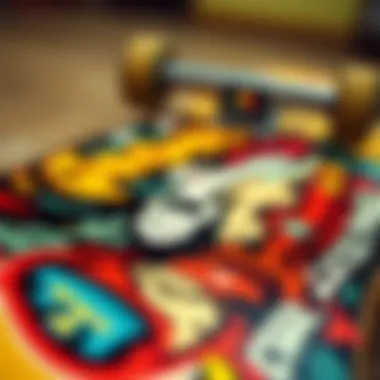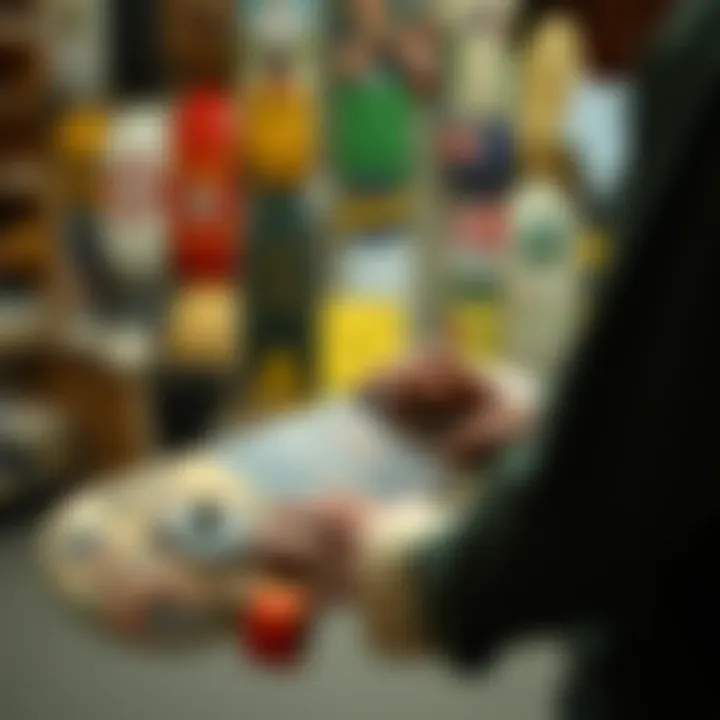Skateboard Collecting: Motivations, Trends, and Community


Intro
Skateboarding is not just a mere sport; it’s a vivid culture that has evolved over decades, embracing creativity and personal expression. Within this vibrant tapestry, skateboard collecting emerges as a unique aspect – a niche that marries passion and investment. Collectors often find themselves drawn to the aesthetic appeal of skateboards, their intricate designs, the stories they tell, and the nostalgia they evoke. Some hunt for limited editions, while others seek out the classics that defined different eras.
In this exploration, we will dive deep into the world of skateboard collecting. From understanding what drives collectors to the importance of the community, this article aims to shed light on various aspects that shape this intriguing facet of the skateboarding realm. Included will be discussions on types of skateboards that captivate collectors, the cultural significance they hold, and trends that are currently influencing designs.
Joining us in this venture, enthusiasts, skaters, parents, and marketers will find insights that enrich not only their knowledge but also their appreciation for this incredible hobby. All in all, the goal is to provide a thorough understanding of how skateboard collecting intersects with creativity, culture, and investment.
The Evolution of Skateboarding
The evolution of skateboarding encapsulates far more than just the progression of a physical sport; it chronicles a cultural metamorphosis. Delving into the history and innovations of skateboarding reveals how this seemingly simple activity morphed into a global phenomenon. Understanding this timeline is vital for skateboard collectors, as the significance of specific designs, brands, and styles often stems from their eras of production. Collecting skateboards isn't merely about possession; it's like holding a piece of the past in one’s hands, providing insights into societal trends and youth culture through the decades.
A Historical Overview
Skateboarding's roots can be traced back to the 1940s when surfers in California sought ways to catch waves on land. These early forms were akin to wooden boxes with roller skate wheels attached — a far cry from the sleek, artistic decks of today. The 1960s marked a pivotal moment, introducing commercial production and more refined designs. Brands like Hobie and Makaha began to craft boards that were specifically designed for skateboarding.
Beyond just the product, the culture evolved. The emergence of skate parks in the 1970s dramatically changed the game, offering dedicated spaces for practice. Names such as Tony Hawk started gaining fame, immortalizing the culture further. Fast forward to the late 90s and early 2000s, and skateboarding had solidified its position in the mainstream, with events such as the X Games featuring not just skateboarding but also the lifestyle that came with it. The transition from utility to art, blendng street styles and expressions into unique designs, delineated the importance of skateboard art in this historical narrative.
Key Innovations and Milestones
The history of skateboarding is punctuated by essential innovations and milestones that have shaped its trajectory:
- The Introduction of the Plastic Deck: In the 1970s, the introduction of the plastic deck changed the game. With manufacturers like Nash offering colorful options, accessibility skyrocketed, attracting youth from diverse backgrounds.
- The Avant-Garde Skateboard Designs: The late 80s showcased an artistic explosion on skateboard decks. Artists like Jim Phillips and Vivi Averso created eye-catching graphics that contributed to the scene’s identity. Such designs are not just aesthetic; they narrate stories that resonate deeply with collectors today.
- The Invention of the Ollie: This trick emerged in the late 1970s and revolutionized the sport, allowing skaters to perform aerial moves. It altered how boards were used and introduced a new set of possibilities.Dynamic tricks came to define the culture.
- Digital Age Influence: The rise of the internet in the 90s and 2000s expanded the community. Collectors began sharing their finds online, and platforms like eBay provided new avenues for purchasing vintage boards. This era saw collectors navigating increasingly global markets, valuing boards from various regions or limited editions from reputable manufacturers.
"Skateboarding is not just about movement; it is about culture, art, and individual expression. The evolution of this sport illustrates our shifting societal values and innovations."
In essence, tracing the evolution of skateboarding allows collectors to appreciate not only the boards themselves but the narratives they carry. Each board tells a tale, whether of a childhood memory, a moment of artistic expression, or the thrill of a new trick. For enthusiasts, understanding these historical contexts enhances both collecting and connection to the skateboarding community.
For additional insights on the history of skateboarding, you may explore Wikipedia and articles on Britannica.
Skateboarding is more than a pastime; it’s akin to collecting historical artifacts that embody the essence of a generation.
Understanding the Appeal of Collecting Skateboards
The realm of skateboard collecting is a multifaceted one, resonating with enthusiasts on personal, aesthetic, and financial levels. It’s not merely about owning a piece of wood with wheels; it’s about connecting with memories, appreciating artistry, and considering the potential growth of one’s collection as an investment. The appeal can be dissected into three significant areas: nostalgia and memory, aesthetic value, and investment potential. Each of these aspects plays a crucial role in drawing individuals into this vibrant hobby.
Nostalgia and Memory
Nostalgia can hit hardest when one reflects on formative years spent skateboarding or watching their favorite skaters glide effortlessly through the streets. For many, the act of collecting skateboards serves as a bridge to the past, tapping into cherished moments that shaped their identity. An older deck may remind a collector of their first competition, while a limited-edition release might bring to mind a favorite skate video that defined an era.
This emotional connection transforms a simple object into a powerful symbol of shared experiences. A collector might find joy in rare items, perhaps reminiscent of the golden age of skateboarding. Keywords like "90s skate culture" or "childhood memories" thus become integral to the collection narrative. In this way, the memorabilia serves not just as a collectible, but as a vessel for preserving stories—translating the past into a tangible form that can be appreciated by both the owner and viewers. To illustrate, consider this insight:
"Every board I have tells a story, be it the first one I ever skated or the one with my favorite pro’s autograph. It's like unlocking a treasure box of memories."
Aesthetic Value
Beyond the sentimental aspects, skateboard collecting also taps deeply into the world of art and design. With vibrant graphics, innovative shapes, and unique materials, every deck is a canvas reflecting the creativity of the artist. Many collectors take pride in displaying their boards, turning their collection into an art gallery of sorts.
Artistic decks often collaborate with renowned artists, creating pieces that hold both skate and artistic value. Notable names in contemporary art and skateboarding—like Keith Haring and Shepard Fairey—have added depth to the aesthetic appeal of skateboards, making them coveted collectibles in both worlds.
Further, design trends ebb and flow, and collectors keenly observe these changes, leading to the acquisition of boards that resonate with current cultural aesthetics. Here’s a short compilation of aspects that underscore aesthetic value:
- Bold graphics and color schemes
- Limited edition designs
- Collaboration pieces with artists
- Innovative shapes that break conventional molds
This blend of artistry and utility makes each piece a conversation starter, not just among skaters, but also within the realms of art and design.


Investment Potential
Lastly, there's the aspect of financial investment. Over the years, certain skateboards have appreciated significantly, attracting not just enthusiasts but also investors looking for unique portfolio diversification. A collector's evaluation of their collection often intertwines with market trends, scarcity, and the cultural impact of the boards they own.
Some specifically sought-after boards can exceed valuations of thousands of dollars, indicating a burgeoning market that appreciates historical significance and rarity. Collectors need to stay informed, watching trends and understanding which models may become future classics.
- Limited editions tend to be more valuable.
- Condition matters; meticulously kept boards fetch higher prices.
- Pro models often appreciate due to the popularity of the skater.
Keeping an eye on platforms like eBay and dedicated forums on Reddit can provide insights into market movements. Such diligence in research often leads to fruitful investments, marrying passion with economic acumen.
Overall, understanding the appeal of collecting skateboards gives collectors a solid ground to navigate their pursuit, balancing nostalgia, beauty, and investment savvy as they build their unique collections.
Types of Skateboards to Collect
When it comes to skateboard collecting, an array of styles and categories beckons enthusiasts, each holding unique stories and values. Understanding types of skateboards to collect is essential for curators and casual hobbyists alike. These skateboards often represent not just a piece of sport equipment, but rather are tangible slices of cultural history. Knowing the distinctions can elevate one's collection from a mere assortment of boards to a curated display of art and innovation.
Vintage Skateboards
Vintage skateboards hold a special place in the hearts of collectors. These boards represent the golden eras of skateboarding, often characterized by distinct designs and materials typically made in the 1970s and 1980s. Collectors value their aged appearance and the nostalgia they invoke. Hauntingly beautiful and often adorned with eye-catching graphics, vintage skateboards aren't just functional; they’re conversation starters, family heirlooms, and sometimes even investments.
Many collectors are drawn to the stories behind vintage boards. For instance, a skateboard used by a legendary skater may carry narratives far deeper than ink or wood. Such collectibles tend to appreciate in value significantly over time. Brands like Powell Peralta, Santa Cruz, and Dogtown are prevalent among vintage enthusiasts, with specific models becoming highly sought after. Ensure you buy from reputable dealers and check for authenticity, as duplicates can often slip into the market.
Limited-Edition Releases
Limited-edition releases are another cornerstone of skateboard collections. These boards are often produced in small quantities and may feature exclusive graphics, collaborations, or special materials. This limited availability not only creates a buzz among collectors but also often drives up their market value. Collectors often want what others can’t easily obtain, and these releases fit that bill perfectly.
Notable collaborations, like those between popular skateboard companies and high-fashion brands, bring a new edge to collecting. Collectors should keep an eye on drops from brands like Element and Baker Skateboards coupled with artists’ unique input. Some find it gratifying to secure a coveted board that no one else around has, heightening the sense of personal achievement.
Limited editions often tell a specific narrative or reflect a cultural moment, making them rich with significance.
Artistic Decks
The world of artistic decks offers a fascinating intersection of creativity and craftsmanship. These skateboards showcase artwork or designs that elevate them from standard skateboards to coveted art pieces. Many artists, both well-known and up-and-coming, collaborate with brands to create visually stunning skateboards that are as much about aesthetics as they are about skating.
Collectors appreciate these decks for their visual appeal and the uniqueness they bring to a collection. They often serve as wall displays rather than being used for skating—something that can prompt conversations about artistry in sports.
Skateboard companies like Almost and Anti-Hero frequently commission artists to lend their style to decks, merging the worlds of street art and skate culture. The artistic deck category allows collectors to bask in the beauty of their passion while supporting the artists behind the pieces.
Building a Skateboard Collection
Grabbing your first skateboard is often a spark that ignites a passion for collecting. Building a skateboard collection isn’t just about having various boards; it’s about cultivating a personal journey and creating a narrative behind each piece. Each skateboard represents a chapter of the sport's history, and can also be a reflection of the owner's identity. With so many nuances involved in the collection process, understanding how to build a robust collection can enrich this experience tremendously.
Researching and Sourcing
When embarking on the adventure of collecting skateboards, thorough research is key. Collectors often find themselves lost in the diverse options available. From vintage boards from the 70s to modern limited editions, the variety can feel overwhelming. A good starting point is joining online communities, such as those you might find on reddit.com, where collectors exchange insights and recommendations.
- Attend Forums and Conventions: Participating in skateboard conventions or auctions can lead to some unexpected finds. These gatherings often have vendors and fellow enthusiasts with in-depth knowledge about specific models.
- Utilize Online Marketplaces: Websites like eBay and Facebook Marketplace are treasure troves of collectible skateboards. However, always verify the seller’s reputation and the skateboard’s authenticity.
- Local Shops and Flea Markets: Don’t underestimate the smaller local shops or flea markets. Sometimes, you can stumble upon an exquisite piece just waiting to be appreciated once again.
Researching diligently will not only help in uncovering unique items, but also in understanding the market trends, which is fundamental for any serious collector.
Setting a Budget
Set a realistic budget before diving headfirst into the collecting realm. Skateboards can vary in price from budget-friendly options to jaw-dropping collectibles worth thousands.
- Consider Board Types: Vintage boards generally command higher prices due to their rarity. On the other hand, newer brands might offer limited runs at more accessible prices.
- Allocate Funds for Maintenance: Budgeting should also encompass maintenance expenses, which include cleaning supplies, protective gear for display, and possibly insurance for high-value items. A well-maintained collection speaks volumes about its owner and preserves value over time.
- Be Patient: Avoid splurging impulsively on the latest hype. Sometimes the best pieces come across unexpectedly at a great deal. Holding out can provide more flexibility to secure a truly valuable addition.


What’s key is finding a fine balance that allows you to enjoy the collection process while also protecting your financial well-being.
Organizing Your Collection
Once you have a foundation to your collection, organizing it becomes crucial. An organized collection not only enhances the aesthetic appeal but also makes it easier to manage and appreciate.
- Inventory Management: Keeping a detailed record of each board’s condition, purchase date, and value can be beneficial. Utilize spreadsheets or apps designed for collectors to track this information efficiently.
- Display Considerations: Where and how to display your collection should reflect your personal style. Floating shelves, shadow boxes, or even dedicated walls can turn your collection into a striking visual statement.
- Regular Reviews: Regularly reassessing your collection can spark new enthusiasm. Maybe you discover a board has appreciated in value, or perhaps it’s time to let go of a piece that no longer resonates with you.
In essence, the way you build and maintain your skateboard collection can transform it from mere possessions into an intricate history captured on wooden decks.
Caring for Your Skateboard Collection
Taking care of a skateboard collection is crucial for both preservation and value. A well-maintained collection tells a story of creativity, history, and culture. For enthusiasts and occasional collectors alike, understanding how to properly care for these unique pieces of art is not only rewarding, but also essential for keeping their investment intact. In this section, we'll delve into the cleaning and maintenance practices that can keep your boards looking sharp, as well as some tips on how to display your collection to spotlight its best features.
Cleaning and Maintenance
Regular cleaning is the backbone of maintaining your skateboard collection. Dust and debris can accumulate quickly, and if left unattended, these particles can wear down the finish or, worse, lead to deterioration. Here are crucial elements to consider:
- Use Appropriate Cleaning Materials: It's vital to avoid abrasive cleaners that can scratch the surface of the decks. Soft microfiber cloths coupled with mild detergents or specially formulated skateboard cleaners will do wonders.
- Routine Inspection: Check for scuffs and scratches during cleaning. This gives an opportunity to identify any damage early and decide if touch-up paint or repairs are needed.
- Handle with Care: Always pick up your boards by the edges. Holding them by the center can put unnecessary stress on the deck, possibly leading to warping.
Seasonal Maintenance: Going all out in spring cleaning can be beneficial. Once a season, a detailed review of each board ensures you're not caught off guard by any hidden issues. Something as simple as a change in humidity can affect wood, so keeping tabs on your environment is key.
"Preserving the integrity of a skateboard is like preserving a piece of history. Each scratch tells a story, but neglect can erase it."
Displaying Your Collection
A well-displayed skateboard collection not only amps up the aesthetics of your living space but also connects you and your guests to the rich culture of skateboarding. Here are strategies to declare your passion while protecting your boards:
- Select the Right Display Method: Wall mounts, shadow boxes, or display cases are effective ways to showcase your collection. Wall mounts allow you to feature your boards vertically, enhancing visibility while saving floor space. Consider custom mounts that match the décor of your room.
- Lighting: Good lighting can elevate the appearance of your collection. Use natural light when possible, but avoid direct sunlight that can fade colors. LED lights can cast a warm glow without causing damage.
- Temperature and Humidity Control: Keep your collection in a stable environment. High humidity can warp wooden boards, while extremely dry conditions can lead to cracking.
- Rotation of Display: Regularly rotate featured boards to avoid uneven fading and to keep the display fresh. This way, each board gets its moment in the spotlight.
Pairing these display strategies with proper care creates a presentation that honors both the art of skateboarding and your unique journey as a collector.
The Cultural Impact of Skateboard Collecting
Skateboard collecting extends beyond mere hobbyism; it serves as a vibrant intersection of culture, memory, and identity. As skaters evolve and the sport garners mainstream recognition, the nuances surrounding skateboard collecting often highlight significant elements that reflect cultural attitudes and history. Collectors don’t just seek out the physical decks; they delve into narratives encapsulated within each piece. The act itself has become a means of storytelling and community-building, reminiscent of times gone by while influencing the future of skateboarding.
Community Perspectives
The skateboard community embodies a unique camaraderie, punctuated by shared experiences and common passions. Collectors form a tapestry that interweaves varied backgrounds, creating bonds through love for skateboarding. Perspectives differ widely—from seasoned enthusiasts who reminisce the good ol' days of the 70s and 80s to fresh faces eager to snag the latest limited drops. Conversations range from nostalgic tales of tricks landed on cherished boards to heated discussions about which brands hold their value. It's not uncommon for these exchanges to evolve into strong friendships.
Furthermore, the rise of social media platforms like Instagram and Reddit allows collectors to showcase their finds and connect. Facebook Groups focused on skateboard collecting breed relationships that blend support and competition. Collectors often encourage one another to preserve not just the boards but also the culture that comes with them.
Skateboarding as an Art Form
Skateboards are more than just tools for riding; they are canvases for expression. The graphics painted on decks can range from rebellious street art to intricate, aesthetically pleasing designs, making each board a unique artifact. Artists and brands collaborate to create stunning visuals that resonate with different subcultures. This merging of skate culture and visual art has birthed a movement where skateboards are displayed in galleries, blurring boundaries between functional objects and collectible art pieces.
"A skateboard is a sculpture in motion—a piece of art that lives and breathes with its rider."
As such, collecting becomes a reflection of personal taste and cultural affiliation. Limited-edition skateboards, often signed by the artist or skater, are highly coveted, frequently appreciating in value not solely based on their condition but also their artistic significance. The appreciation for these designs showcases an intertwining of creativity and performance, inviting collectors to grasp at something more than just a board.
Preserving Memory and History
The history of skateboarding is rich and layered. Each board can tell a story—whether it be about the movement that sparked a generation or the evolution of designs over the decades. Collectors play a crucial role in safeguarding these memories. They hold onto the artifacts of iconic moments in skate culture that would otherwise fade from collective memory. From the first skate decks made of old wood from backyard ramps to today’s technological marvels, collectors act as archivists for this ever-evolving sport.
This preservation not only honors past influence but also fosters a sense of continuity for new skaters. Younger generations can actively learn about skateboarding’s roots through these collections, gaining appreciation for pioneers like Tony Hawk and Rodney Mullen. Therefore, collectors do not merely possess decks; they steward the narrative of skateboarding’s cultural heritage. In a world that often forgets history, skateboard collecting becomes a bastion of nostalgia and reverence for what has shaped today’s skate culture.


In summary, the cultural impact of skateboard collecting encapsulates community, art, and memory. It's a dialogue connecting the past to the future, drawing enthusiasts in and inspiring the next wave of skaters and collectors.
Challenges in Skateboard Collecting
Skateboard collecting is an exciting pursuit, yet like any hobby, it comes with its share of challenges. Understanding these obstacles is crucial as it can greatly enhance one's ability to navigate the intricate landscape of skateboard collecting. From the shadow of counterfeit products to the unpredictable nature of market trends, potential collectors must arm themselves with knowledge. This awareness can not only safeguard investments but also enrich the collecting experience overall. This section aims to illuminate the specific challenges faced by skateboard collectors and highlight importance of being informed.
Counterfeit Concerns
The issue of counterfeit products looms large in the skateboard collecting realm. Many collectors aspire to own authentic vintage boards or limited-edition releases, and the replica market can create confusion. Counterfeit skateboards may look convincing at first glance, but upon closer inspection, the telltale signs often become apparent. For instance, mismatched logos or poor-quality materials can reveal a fake board. Here are some steps to help safeguard against counterfeits:
- Research: Familiarize yourself with the specific details of the skateboard brands and models you're interested in. Resources such as Wikipedia offer valuable insights.
- Buy from Reputable Sources: Always purchase from established dealers, trusted collectors, or at well-known conventions.
- Seek Expert Opinion: If you’re unsure, don’t hesitate to consult with expert collectors or use forums like Reddit where enthusiasts share their experiences.
The scrutiny required to avoid counterfeits may feel tedious, but given how much investment some boards represent, that diligence is worthwhile. Your collection deserves authenticity.
Market Fluctuations
Just as the waves of the ocean ebb and flow, the skateboard market can experience fluctuations that significantly impact value. Various factors such as trends in youth culture, economic instability, and even celebrity endorsements play a role. For instance, a skateboard brand may spike in popularity after being featured in a popular movie or when a famous skateboarder endorses it. This phenomenon can lead to sudden increases in market prices, as seen in the rise of boards associated with legends like Tony Hawk or Ryan Sheckler.
Here are some important considerations when navigating market fluctuations:
- Stay Informed: Follow skateboarding news, communities, and trends. Knowing what's hot and what's not can help you time your purchases or sales better.
- Diversify Your Collection: Invest in a variety of skateboards rather than focusing solely on one type or brand. This approach can help weather market fluctuations more effectively.
- Be Patient: Timing the market perfectly is akin to trying to catch lightning in a bottle. Sometimes, the best strategy is to hold onto your boards and wait for the value to stabilize or grow.
By understanding these challenges and employing the right strategies, skateboard collectors can enhance their collecting journey, while enjoying the intricate tapestry of the skateboard culture.
Future Trends in Skateboard Collecting
As we look ahead, the world of skateboard collecting is shifting in ways that are both exciting and transformative. It's no longer just about owning a piece of art or nostalgia; collectors are increasingly influenced by changing technology, evolving design sensibilities, and a deeper understanding of community engagement. Understanding these trends holds critical importance for skate enthusiasts, collectors, and those looking to invest in this ever-evolving hobby. A grasp of what’s coming down the pike can help collectors make informed decisions, rethink their collections, and adapt to rapidly shifting markets.
Technological Advances
The role of technology in the skateboard industry can’t be overstated. Innovations are cropping up all over, from the materials used to manufacture boards to the apps that help collectors track their inventories and connect with other enthusiasts.
For instance, the integration of augmented reality (AR) is providing a new layer of interaction with skateboards. Imagine being able to visualize how a skateboard would look with certain artwork or colors using your smartphone before you buy. These gadgets are making it easier for collectors to personalize their boards while retaining a digital archive of their collection.
Additionally, platforms that employ blockchain technology are entering the scene, offering a secure means of proving ownership and authenticity for rare decks. With counterfeit products plaguing the market, having a proven lineage could increase the value and desirability of a skateboard exponentially.
"The digital marketplace is not just a trend; it’s a necessity. Understanding how to navigate it can keep your collection relevant and valuable."
Moreover, 3D printing is on the rise, allowing enthusiasts to create custom decks without traditional manufacturing constraints. This democratization of skateboard design paves the way for more unique and personalized boards.
Evolving Aesthetics
As skate culture integrates with new waves of artistic expression, we're noticing a shift in the aesthetics of skateboard design. It's moving away from just logos and graphics; now, concepts like minimalism and eco-friendly designs are gaining traction. Collectors are drawn to boards that tell a story or embody a particular theme, making the collection experience more meaningful.
Artistic collaborations are another significant trend. Renowned artists and designers are stepping onto the scene, creating skateboards that are often perceived as limited-edition art pieces rather than mere sporting equipment. This enhances their appeal both as collectibles and as functional artwork. People are experimenting with all types of mediums—from wood to metal to environmentally sustainable materials—pushing boundaries in ways that can captivate a broader audience.
With the growing awareness around environmental issues, skateboard manufacturers are working hard to integrate sustainable practices into their production lines. Recyclable materials, eco-friendly paints, and sustainable sourcing are not just buzzwords anymore; they're becoming essential aspects of new designs. Collectors may find themselves drawn to decks that resonate with their values, both aesthetically and ethically.
In navigating these trends, skaters and collectors not only ensure their collections are relevant but also reflect broader cultural movements. Balancing traditional aspects of skateboard culture with new influences creates a unique kaleidoscope that enhances both the owner's experience and the community's art scene.
Epilogue
In diving into the world of skateboard collecting, it becomes clear that this pastime offers far more than mere ownership of a piece of wood with wheels. It’s a vivid tapestry woven from personal stories, artistic expression, and community heritage. Every deck tells a tale, linking the collector not only to trends of skateboarding but also to a broader culture that has shaped the way we view youth, rebellion, and creativity.
Reflecting on one’s collection journey is crucial as it brings a sense of fulfillment beyond material accumulation. Collectors often find joy in reminiscing about how they discovered each skateboard, the thrill of acquisitions, and the camaraderie built through shared interests. This retrospective creates deeper emotional investment, enhancing the value of each piece beyond its monetary worth.
Moreover, engaging with the trajectory of one’s collection fosters a greater appreciation for the craft and design involved in skateboards. It encourages a deeper understanding of the evolution of skateboarding culture and highlights how trends can reflect societal changes. By recognizing these nuances, collectors can navigate the market more effectively and make informed decisions about future purchases.
Investing time in understanding the historical and cultural contexts of skateboard designs can elevate one’s collection from a casual hobby to a profound form of art appreciation. It challenges collectors to think critically about the types of skateboards that resonate with them, be it vintage finds that echo memories or cutting-edge designs that push creative boundaries. This exploration not only solidifies their identity as collectors but also promotes the preservation of skateboarding history for future generations.
As this article has examined various facets of skateboard collecting, it emphasizes the importance of fostering community relationships and participating in discussions surrounding skate culture. Engaging in forums, attending conventions, or even contributing to local skate parks helps collectors broaden their understanding and keep the spirit of skateboarding alive.















